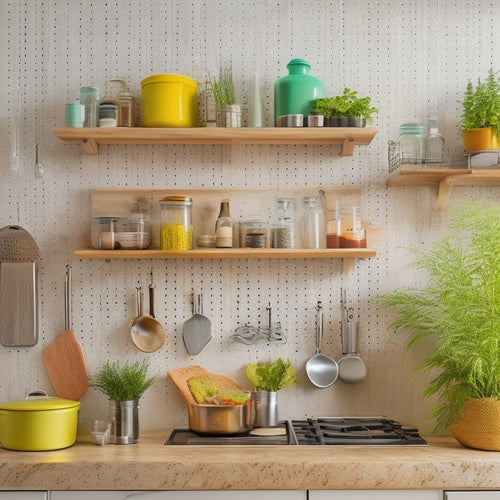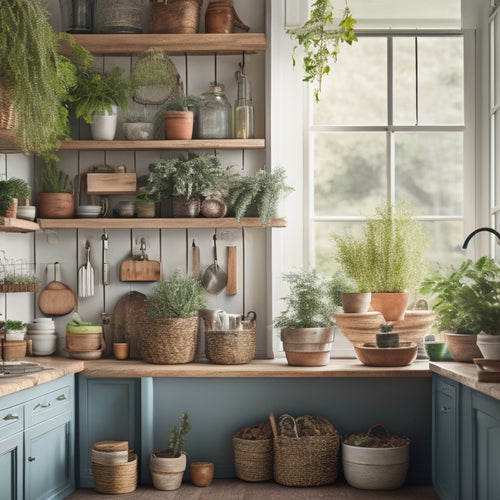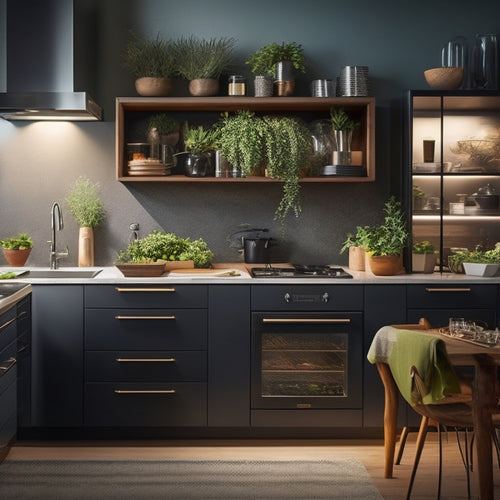Why Plant-Based Diets Need Customized Kitchen Storage
Share
You need a customized kitchen storage system to accommodate the unique demands of a plant-based diet. With ingredients like jackfruit and nutritional yeast, you require specific storage conditions to maintain quality and shelf life. Effective ingredient rotation is vital to avoid expired items, and temperature control is essential for certain ingredients. You'll also need to maximize counter space efficiency, preserve fresh produce, and organize your pantry with specialized tools. By optimizing your kitchen storage, you can streamline meal prep, reduce food waste, and make the most of your plant-based staples. Explore how to create a tailored kitchen setup that works for you.
Key Takeaways
• Plant-based diets require unique ingredients with specific storage needs, such as jackfruit and nutritional yeast, to maintain quality and shelf life.
• Customized storage solutions, like adjustable shelving and spinning spice racks, help maximize kitchen space and keep ingredients organized and accessible.
• Effective ingredient rotation and 'first in, first out' policies are crucial to avoid expired items and reduce food waste in a plant-based kitchen.
• Temperature control is essential for certain ingredients, like flour and nutritional yeast, which demand specific storage conditions to preserve their quality.
• A well-designed kitchen with specialized tools and gadgets, such as spiralizers and food processors, facilitates meal prep and portion control for a balanced plant-based diet.
Unique Ingredient Storage Needs
When adopting a plant-based diet, you'll likely find that your pantry and kitchen storage needs a refresh to accommodate unique ingredients like jackfruit, nutritional yeast, and various types of flour. These ingredients often require specific storage conditions to maintain their quality and shelf life.
Effective ingredient rotation is critical to guarantee that older items are consumed before they expire, making room for new stock. Implement a 'first in, first out' policy to avoid expired or spoiled ingredients.
Temperature control is also essential for certain plant-based ingredients. For instance, some types of flour are sensitive to heat and moisture, requiring a cool, dry storage space. Nutritional yeast, on the other hand, should be stored in an airtight container in the refrigerator to preserve its nutritional properties.
Maximizing Counter Space Efficiency
You'll want to optimize your counter space to accommodate the unique demands of plant-based cooking, where prep work often involves chopping, sautéing, and simmering a variety of ingredients. This means considering vertical storage solutions that maximize your kitchen's vertical real estate.
Install shelves, hooks, or a pegboard to keep frequently used items like utensils, spices, and oils within easy reach, freeing up counter space for food prep.
Compact appliance integration is also key to counter space efficiency. Downsize to space-saving appliances like a compact blender or food processor, and consider investing in a multi-functional tool that can handle various tasks. This will reduce clutter and create a more streamlined workspace.
By implementing these strategies, you'll be able to efficiently chop, cook, and serve a variety of plant-based dishes, all while maintaining a clean and organized kitchen. Remember, a well-designed kitchen is essential to serving others with love and care.
Fresh Produce Preservation Strategies
To maintain your plant-based kitchen remains stocked with fresh, nutritious ingredients, learn how to properly store and preserve your produce to extend its shelf life and reduce food waste.
A well-organized refrigerator is essential for keeping your fruits and vegetables fresh for a longer period. Here are some tips to help you conserve your produce:
-
Store fruits and vegetables separately, as some fruits like apples and bananas release ethylene gas, which can ripen vegetables quickly.
-
Keep highly perishable items front and center, such as berries, leafy greens, and herbs, to ensure you use them before they spoil.
-
Designate a crisper drawer for high-moisture items, like cucumbers, carrots, and celery, to maintain peak humidity levels.
- Utilize freezing techniques, such as blanching and flash freezing, to conserve seasonal produce for future meals.
Specialized Pantry Organization Tools
With your refrigerator optimized for fresh produce, turn your attention to your pantry, where specialized organization tools can help you maximize storage capacity and keep your plant-based staples within easy reach. You'll want to focus on creating a labeling system that allows you to quickly identify the contents of each shelf and bin. This can be achieved using labels, baskets, and bins that are specifically designed for pantry organization.
| Tool | Purpose | Benefits |
|---|---|---|
| Adjustable shelving | Customize shelf height to fit different sizes of plant-based staples | Maximizes storage capacity and reduces clutter |
| Stackable bins | Store dry goods like grains, nuts, and seeds | Keeps contents fresh and organized |
| Spinning spice rack | Holds a variety of spices and seasonings | Easy access to frequently used items |
Meal Prep and Portion Control
As you shift to a plant-based diet, mastering meal prep and portion control becomes essential for maintaining a healthy and balanced lifestyle. Meal planning is key to ensuring you're getting the right nutrients, and kitchen gadgets like spiralizers and food processors can make prep work a breeze.
When it comes to portion control, it's pivotal to have the right tools.
Here are a few must-haves:
-
Food containers: Invest in a set of reusable containers in various sizes to store and transport your meals.
-
Portion control cups: These help you measure out perfect portions every time.
-
Kitchen scale: Accurately measure ingredients and portion sizes with a digital kitchen scale.
- Meal planning app: Download an app that helps you plan and track your meals, ensuring you're meeting your nutritional needs.
Customized Cabinet Solutions Required
Organizing your kitchen storage is essential for a seamless plant-based meal prep experience, and customized cabinet solutions can help maximize your space and efficiency. You'll want to optimize your cabinet layout to accommodate your specific needs, ensuring that frequently used ingredients and cooking essentials are easily accessible.
This is where customized shelving comes in – tailored to your unique requirements, it will streamline your workflow and reduce clutter.
To take your ingredient organization to the next level, consider installing adjustable shelves, baskets, or bins that can be adapted to fit different sizes and shapes of containers. This will enable you to categorize and store your plant-based staples, such as grains, legumes, and spices, in a logical and visually appealing way.
Frequently Asked Questions
How Do I Prevent Cross-Contamination of Plant-Based and Non-Plant-Based Foods?
"As you prep meals, imagine a petri dish of bacteria spreading, threatening your health. To prevent cross-contamination, you separate ingredients, allocating specific storage solutions, and optimize kitchen organization, ensuring a safe haven for your plant-based and non-plant-based foods."
Can I Use Existing Kitchen Utensils for Plant-Based Meal Prep?
You can use some existing kitchen utensils for plant-based meal prep, but consider dedicating specific tools for ingredient separation to avoid cross-contamination. Invest in meal prep tools and storage solutions to optimize kitchen organization.
Are There Any Plant-Based Diet-Specific Kitchen Cleaning Products Recommended?
'As you immerse yourself in plant-based meal prep, don't let harsh chemicals rain on your parade! Opt for plant-based kitchen cleaners and eco-friendly cleaning products that are gentle on surfaces and the environment, ensuring a sparkling clean kitchen that shines with love and care.'
How Do I Store and Organize Plant-Based Milk Alternatives at Home?
You'll want to optimize your pantry organization and storage solutions for plant-based milk alternatives, and consider reconfiguring your refrigerator layout and shelf organization to keep them fresh and easily accessible.
Can I Convert My Existing Kitchen Into a Plant-Based Kitchen on a Budget?
You can easily convert your existing kitchen into a plant-based haven on a budget by incorporating budget-friendly renovations and creative storage solutions, such as repurposing old furniture or using vertical space for maximum efficiency.
Related Posts
-

Stylish Pegboard Storage for Open Kitchen Concepts
Stylish pegboard storage can completely enhance your open kitchen concept, merging practicality with contemporary fla...
-

Countertop Storage Ideas for Small Kitchens
If you're looking to maximize your small kitchen, creative countertop storage solutions can make a big difference. Em...
-

Smart Kitchen Countertop Storage Innovations
Smart kitchen countertop storage innovations are transformative for maximizing your kitchen's potential. You can clea...


